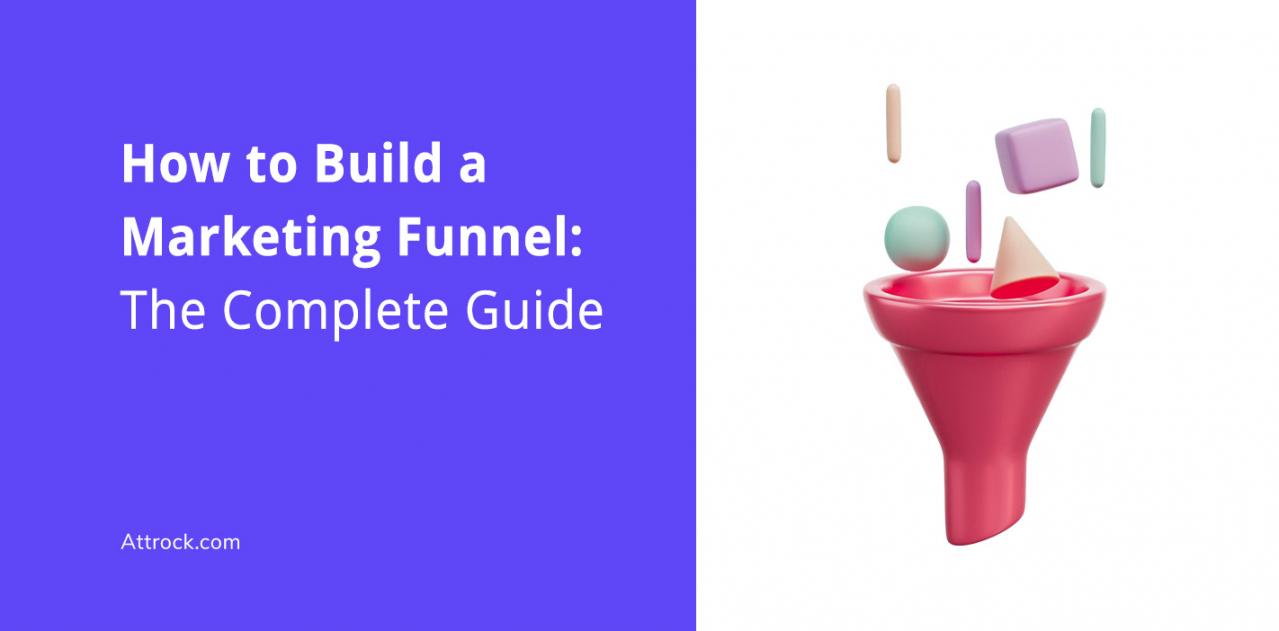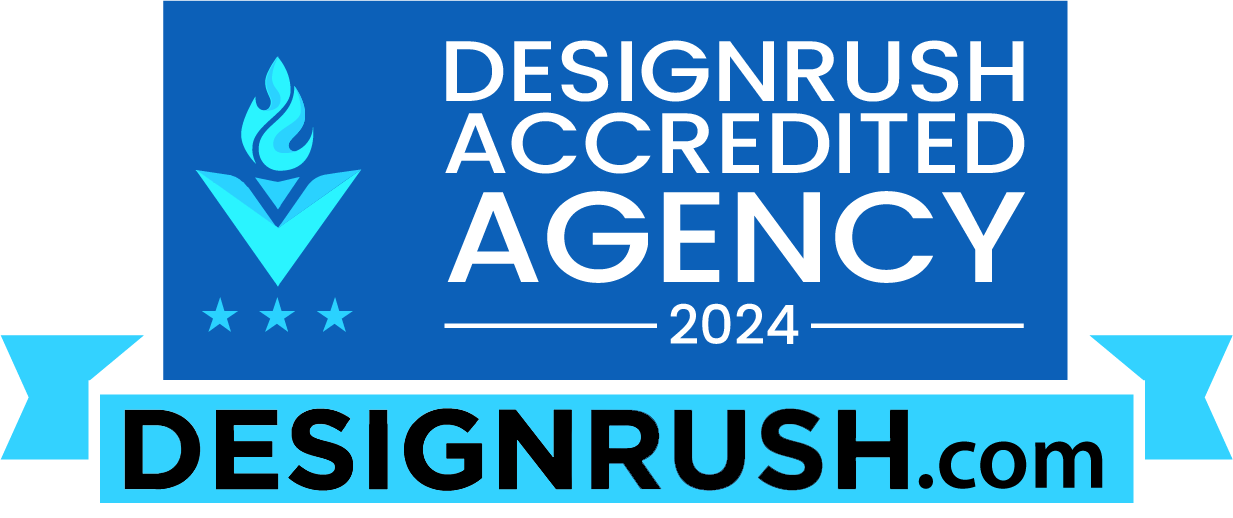Your sales funnel metrics dictate how your business is performing and how you can take it to the next level.
By paying attention to them, you can gain actionable insights into what’s working and what’s not in your sales funnel and make data-driven decisions.
In this blog post, we'll explore the top sales funnel metrics that can help keep your business on track.
From customer acquisition costs to conversion rates and customer lifetime value, we'll cover the key metrics you must track to put your marketing strategy on track and drive growth for your business.
Table of Contents
7 Important Sales Funnel Metrics to Track
The sales funnel metrics you need to track may depend on the nature of your business, the industry, and your sales goals.
In any case, here are the most important sales funnel metrics that are commonly tracked.
Total Leads Generated
Sales qualified leads are the number of people who enter the sales funnel and match your target audience.
Why measure this metric?
First, it helps you understand how many qualified sales leads enter the sales funnel at different stages.
The buying process is increasingly becoming non-linear as buyers explore different paths and touchpoints within the sales process based on their interests, needs, and preferences.
For instance, leads may see an ad or a review to directly purchase a product instead of researching and comparing it with other products in the market. This changes the sales funnel completely.
Here’s an example of a non-linear sales funnel.

Image via Behavioral Response
Plus, knowing the number of total leads will let you calculate how many or what percentage of leads convert into customers.
You can also look at the sales cycle or the time it takes for a qualified lead to convert into a paying customer.
Each of these sales funnel metrics will help you assess the efficiency of your lead generation strategies.
To measure the total leads who enter your sales funnel, you can follow these steps:
Define what a “lead” means for your business: A lead is someone who has shown interest in your product or service by taking a specific action, such as filling out a contact form, downloading a free resource, or requesting a demo.
Identify the sources of your leads: Make a list of all the channels that drive traffic to your sales funnel, such as cold calls, social media, email marketing, search engine optimization, paid advertising, events, referrals, etc.
Set up tracking for each channel: Use tracking tools such as Google Analytics, marketing automation software, or CRM software to track leads generated from each source.
For instance, GetResponse, one of the ClickFunnels alternatives, gives you a detailed view of your leads, including unique website visits, page views, location, devices, etc.
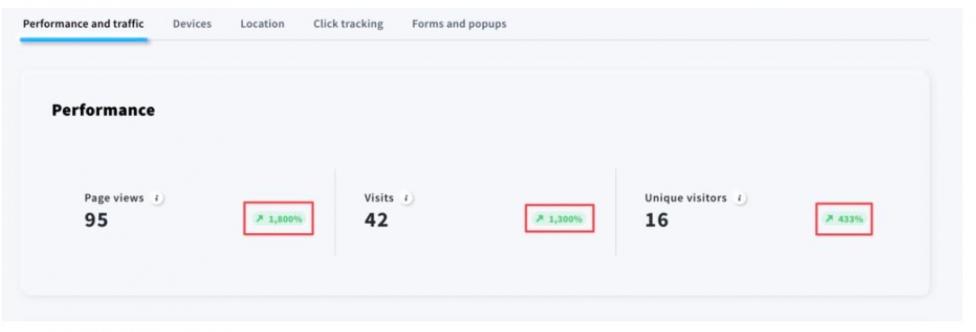
Image via GetResponse
Track the leads at each stage of the funnel: Track the number of leads at each stage of the funnel to find out where most are dropping out.
Summing up: Once you have tracked the number of leads generated from each source and at each stage of the funnel, add them up to get the total number of prospective customers entering your sales funnel.
Once you have the total number of leads, you can analyze the data to identify which channels and stages of the funnel are generating the most leads and which ones need improvement.
This will help you optimize your sales funnel to generate more high-quality leads that will likely convert.
Conversion Rate
As one of the important sales funnel metrics, conversion rate indicates the percentage of leads who take your desired action (e.g. make a purchase, sign up for a newsletter) out of the total number of leads.
It helps you understand how effectively your sales funnel converts leads into paying customers.
But, how to calculate conversion rate?
You already know that a typical sales funnel consists of multiple stages that a prospect goes through before making a purchase. The stages include:
Awareness Stage
In the awareness stage, potential customers discover your business through ads, social media, or word-of-mouth. Businesses use sales funnel metrics here to measure reach and engagement. Metrics like website traffic or impressions help identify what attracts attention so you can refine your marketing strategies for better results.
Interest Stage
In the interest stage, potential customers show curiosity about your products. They might sign up for newsletters or follow your social media. You can use sales funnel metrics like click-through rates and email open rates to track their interest.
This data helps businesses see which efforts are working best. The interest stage is key for building connections with potential buyers.
Consideration Stage
In the consideration stage, customers weigh their options. They compare products, read reviews, or request more information. Sales funnel metrics like time spent on product pages and bounce rates are vital here.
These specific sales funnel metrics tell you how engaged customers are with your offerings. You can use this data to improve your product pages or follow up with prospects.
Decision Stage
The fourth stage is the decision-making process, where customers decide whether to buy or not. This is when your business really needs to shine by offering discounts, testimonials, or clear calls-to-action.
Sales funnel metrics like conversion rates and abandoned cart rates provide valuable insight. Tracking these numbers helps you pinpoint obstacles that stop customers from completing purchases.
Purchase Stage
The purchase stage is the final and ultimate goal of the sales funnel. In this stage, customers complete their transactions and become buyers. You need to use sales funnel metrics like average order value and repeat purchase rates to measure success. Retaining customers becomes a new focus after this stage.
Now, you can calculate the conversion rate at each stage of this process.
To do this, divide the number of prospects who moved from one stage to the next by the number of prospects in the previous stage.

To illustrate, let’s assume 4000 people entered the sales funnel. Here’s the conversion rate at each stage of the funnel.
| Entered the sales funnel | Became aware | Are interested | Are evaluating | Have bought |
| 4000 | 1000 | 400 | 200 | 100 |
| Conversion rate at each stage | 25% | 40% | 50% | 50% |
You can now calculate the overall conversion rate by dividing the number of people who made the purchase by the total leads that entered your funnel (100/4000 x 100).
This gives you an overall conversion rate of 2.5%.
Customer Lifetime Value (CLV)
CLV is yet another important sales funnel metric that represents the total amount of revenue a customer is expected to generate over the course of their relationship with your business.
It can help you identify your most valuable customers and tailor your sales and marketing strategies to your target audience.
The higher the CLV, the more revenue your business earns from each customer. Plus, by optimizing CLV, you can reduce your customer acquisition costs, one of the key sales funnel metrics we’ll discuss in the next section.
To calculate your CLV, use this formula:

Customer value is the average amount of revenue generated by a customer in a given period. To calculate this, multiply the average purchase value with the average purchase frequency.
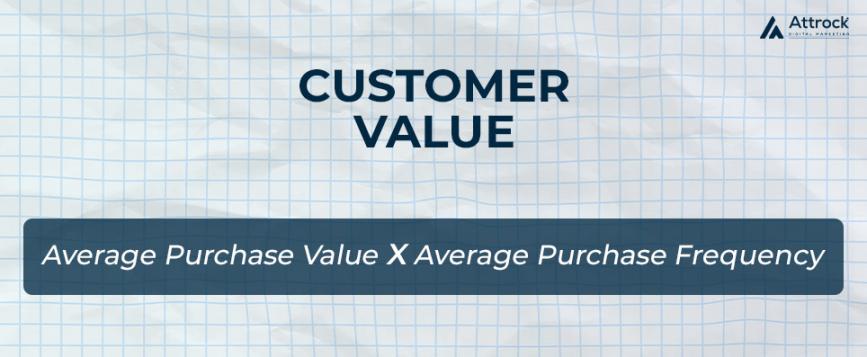
Next, calculate the customer lifespan. This is the average time a customer stays with your business before they stop purchasing. To calculate this, determine the average time between a customer's first and last purchases.
Customer lifespan = Average time between first purchase and last purchase
You can now calculate your customer lifetime value.
You can also analyze your customer lifetime value by using sales tracking tools that give you detailed visibility into your sales funnel metrics.
Cost Per Acquisition (CPA)
This is the average cost of acquiring a new customer for your business. As one of the key sales funnel metrics, it can play a central role in helping you understand the ROI of your marketing efforts and identifying opportunities to reduce costs and increase efficiency.
These days, 96% of consumers conduct their own research about a product or service before engaging the sales team, and a good customer acquisition team needs to be ready for such a situation.
To calculate cost per acquisition for your sales funnel, follow these steps:
- Determine your advertising or marketing spend: This includes all the costs associated with your advertising or marketing campaigns, such as ad spend, content creation costs, and agency fees.
- Determine the number of conversions: This is the number of leads or customers who complete a desired action, such as making a purchase or filling out a form.
- Calculate the CPA: To calculate the cost per acquisition, divide the advertising or marketing spend by the number of conversions.

For example, if you spend $10,000 on advertising and marketing and acquire 100 new customers, your cost per acquisition would be $100.
It's important to regularly monitor and analyze your cost per acquisition to ensure that your costs aren’t going over your CLV, which could render your business unprofitable.
Time Between Purchases
Time between purchases is one of the crucial sales funnel metrics and measures the average time it takes for a customer to make a repeat purchase from your business.
By measuring this metric, you can tailor your digital marketing campaigns and retarget customers to encourage repeat purchases.
To calculate the time between purchases, subtract the date of the first purchase from the date of the second purchase, and then repeat for subsequent purchases.
Add up all the time intervals and divide by the number of purchases minus one to get the average time between purchases.

For example, if a customer makes their first purchase on January 1, their second purchase on March 1, and their third purchase on May 1,
- The time between the first and second purchase would be 59 days
- The time between the second and third purchase would be 60 days.
The average time between purchases would be (59 + 60) / 2 = 59.5 days.
You can use an Excel sheet to calculate this metric.
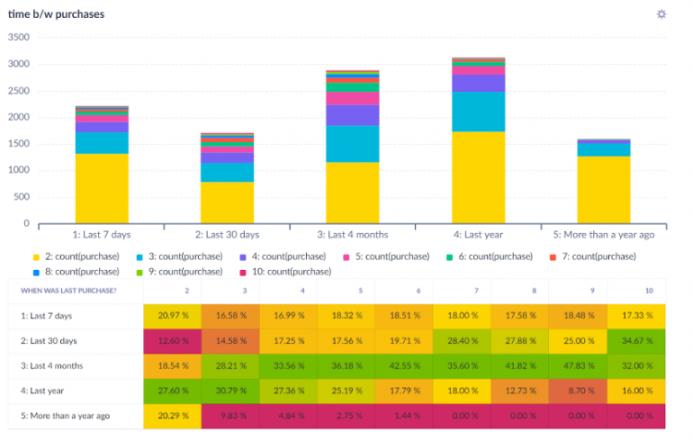
Image via Bloomreach
You could also use alternatives to ClickFunnels to find this metric without having to go through the trouble of creating a spreadsheet.
Funnel Drop-Off Rate
When it comes to sales funnel metrics, you cannot ignore the metric that measures the percentage of visitors who drop off at each stage of the sales funnel. It can help you identify areas where visitors are losing interest or encountering obstacles.
Here’s the formula to use to calculate funnel stage conversion rates:
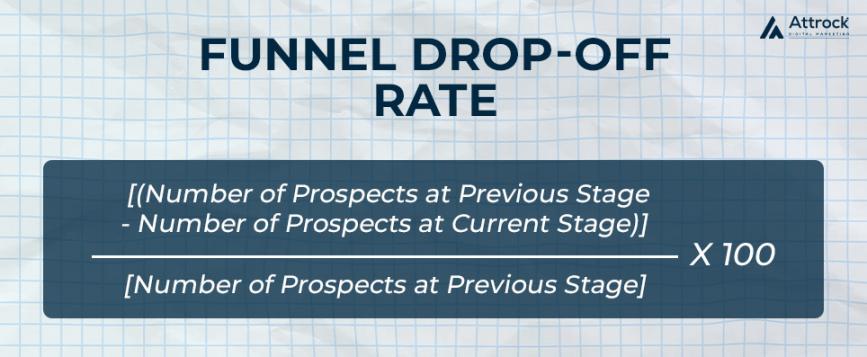
You can keep track of the drop-off rates using tools such as Google Analytics, Hotjar, or Smartlook.
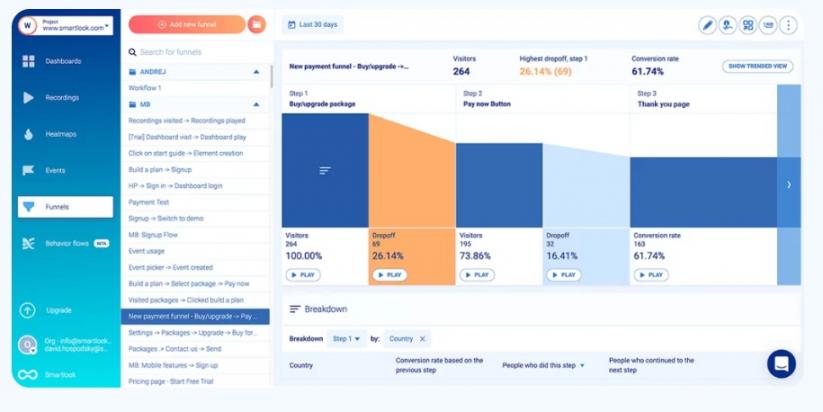
Image via Smartlook
Total Revenue
It's important to regularly monitor and analyze the total sales from your sales funnel to find the effectiveness of your sales and marketing strategies.
As one of the key sales funnel metrics, this measure can help you identify the impact of the changes you make to your sales funnel and enable you to adjust your strategies.
Here’s how you can calculate the total sales:
- Determine the average value of each sale: This is the average revenue generated from each sale.
- Calculate the total sales: Multiply the total number of customers by the average value of each sale.

FAQ
Q1. What are good sales funnel metrics?
A. The right sales funnel metrics can give you insights into the effectiveness of your sales funnel. Some of the key metrics to look out for are total sales leads, conversion rate, CLV, and funnel drop-off rates.
Q2. How do you measure sales funnel success?
A. Measuring the success of a sales funnel is not a one-size-fits-all solution. There are several sales funnel metrics that you can use to assess the performance of your sales funnel, including conversion rates, average order value, lead quality, CLV, and more.
Q3. What are the 5 stages of sales funnels?
A. The 5 stages of the sales funnel are: awareness, interest, evaluation, decision, and action. Each stage is designed to move potential customers through the funnel until they reach the final stage.
Q4. What are the ecommerce funnel metrics?
A. The main ecommerce sales funnel metrics are customer acquisition cost, customer engagement, customer loyalty, average order value, and customer lifetime value.
Q5. What are the B2B sales funnel metrics?
A. The B2B marketing funnel metrics consist of four essential items – lead generation, average deal value, CLV, and conversion rate. The funnel is different here due to the involvement of multiple stakeholders in every purchase decision.
Optimize Sales Funnel Success
By tracking these seven critical sales funnel metrics, your sales team will be able to better understand the customer journey and make informed decisions on how to optimize the sales funnel for maximum results.
Ultimately, by using a combination of analytics and A/B testing, you can continually refine and improve your sales and marketing efforts over time to ensure they deliver maximum ROI.
Which sales funnel metrics have you used to track the performance of your sales funnel? Do let us know!








